The Optical System
The original Dedolight patent introduced a second lens which:
- Produces a unique character of light.
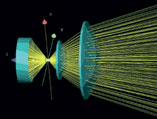
- Pre–collects the light from the lamp and reflector allowing the use of a smaller front lens and thus enabling the construction of a smaller light head.
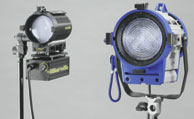 Provides light output comparable to much larger light sources.
Provides light output comparable to much larger light sources. Raised the light efficiency in spot position to 18 % versus only 6 % found in traditional Fresnel designs.
Raised the light efficiency in spot position to 18 % versus only 6 % found in traditional Fresnel designs. Provides a focusing range (change in intensity from flood to spot) of 20:1 versus the 3:1 range of similar lights.
Provides a focusing range (change in intensity from flood to spot) of 20:1 versus the 3:1 range of similar lights.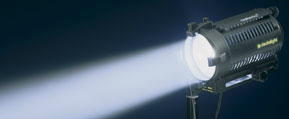 Provides a clean beam without stray light as usually found in Fresnel lights.
Provides a clean beam without stray light as usually found in Fresnel lights. Offers very even light distribution within the beam versus hot spots as produced by Fresnel studio lights.
Offers very even light distribution within the beam versus hot spots as produced by Fresnel studio lights.
Low Voltage Lamps
Using low voltage lamps offers several advantages compared to traditional light sources:
 Produce up to 40 lumens per watt (versus 20–25 lumens per watt of high voltage halogen lamps), further contributing to the enhanced light output.
Produce up to 40 lumens per watt (versus 20–25 lumens per watt of high voltage halogen lamps), further contributing to the enhanced light output.- Provide tremendous savings in operating cost due to their very low price and long life.
- Much less susceptible to premature lamp failure due to shock and vibration, allowing their use in rough applications where line voltage lamps may fail instantly.
 Adding to the economic benefits:
Adding to the economic benefits:
- The Dedolight DLH4 light heads may be used in rain, snow and although not recommended, have been demonstrated while totally immersed in water.
- These lights may be used with our wide choice of AC power supplies and batteries.
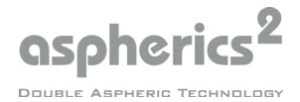 Four years of optical research and development led us to further improvements in professional lighting. The resulting patent introduces a relation computed double aspheric system. This development offers solutions to two problems.
Four years of optical research and development led us to further improvements in professional lighting. The resulting patent introduces a relation computed double aspheric system. This development offers solutions to two problems.
 Traditional studio lights show light distribution with hot spots or in some focusing positions „hot shoulders“ (brighter rims with darker centers).
Traditional studio lights show light distribution with hot spots or in some focusing positions „hot shoulders“ (brighter rims with darker centers).
The Dedolight double aspheric system offers edge to edge, perfectly even and smooth light distribution in all focus positions that is even cleaner than the pre-vious generations of Dedolight models.
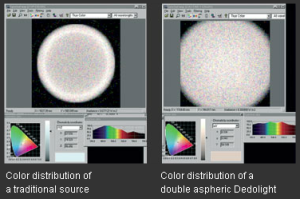 Discharge lamps do not have homogenous color properties, which often lead to bluish rims in some focus positions.
Discharge lamps do not have homogenous color properties, which often lead to bluish rims in some focus positions.
Our patented double aspheric system provides significant improvement in the color distribution across the entire lit field.
The Mechanics
An additional patent introduced the added movement of the second lens in relation to the lamp and reflector all
being controlled by one focusing knob. This technology was first used in the Dedolight Series 400 as a triple
zoom focus.
- 20:1 variation of intensity from spot to flood–Series 400
- 25:1 variation of intensity from spot to flood–Aspherics²
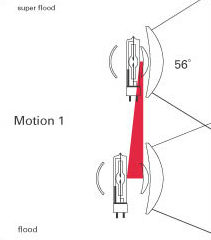 Motion 1
Motion 1
- From flood to super flood.
- Lamp and mirror move closer to the second lens.
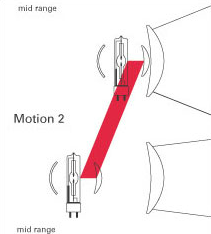 Motion 2
Motion 2
- Mid range.
- Lamp, mirror and second lens move in equidistant unison.
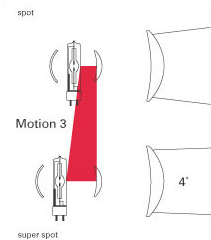 Motion 3
Motion 3
- Spot to super spot.
- Second lens stops while the lamp and mirror continue their travel.
UV radiation is produced by many light sources. UV–C, the shortest wavelength, is the most hazardous type
of radiation, and although natural sunlight contains a great deal of UV–C, this is fortunately filtered out by the
ozone layer. Using artificial daylight sources like metal halogen (HMI), we’re also subject to dangerous levels
of this type of UV. No metal halogen light source should ever be used for direct lighting of people or sensitive
objects without some form of protection.
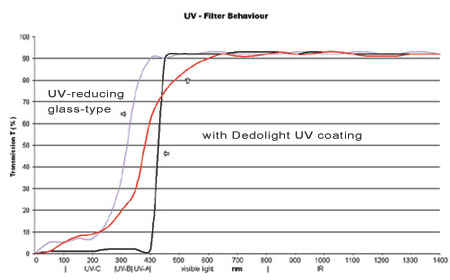
A degree of protection may be provided by additives to the glass during manufacture or by utilizing special
UV absorbing glass. This type of filtering may produce a color shift and loss of light, and still won’t entirely
cut out UV.
We have been successful in developing a filter coating which effectively cuts UV–A, UV–B and UV–C radiation
below 405 nm. This coating is deposited on the inner side of the front lens and does not affect the visible light,
color rendition or transmission. The UV emission of our daylight sources (DLH400D and DLH200D) is approx-
imately 1/20 th (5 %) of the UV emission of comparable light sources.
On our 400/575 W and 200 W daylight soft lights we utilize a doted quartz glass tube which effectively lowers
UV values givingsignificant advantages over similar light sources. Our Series 200 lamps are manufactured with
a UV stop envelope which does not lower UV values beyond our coating, but may be regarded as a backup
safety.
The UV content from halogen light sources is regarded as less harmful to people lighting but will still affect
sensitive objects such as textiles, paintings and photographs. We offer an optional UV protection which is
commonly used in museum lighting. Our special dichroic filter technology offers the lowest UV values in the
professional lighting world.
